Or "Will the Real Noilly Prat Please Stand Up."... or perhaps I am the only one who remembers the old "To Tell The Truth" show?
 It was over a year ago that I first heard that Noilly Prat, my favorite dry vermouth, was going to change its formula. When Coca-Cola changed their formula to "New Coke", I was right there with the rest of the world in rebelling against the corporate fiddling with this classic flavor. Thankfully they realized the error of their ways and before long "New Coke" was simply a footnote in the history books.
It was over a year ago that I first heard that Noilly Prat, my favorite dry vermouth, was going to change its formula. When Coca-Cola changed their formula to "New Coke", I was right there with the rest of the world in rebelling against the corporate fiddling with this classic flavor. Thankfully they realized the error of their ways and before long "New Coke" was simply a footnote in the history books.
While not being too manic about it, I had been occasionally picking up an extra bottle or two of the old stuff, just in case this new product was "New Coke" all over again. Finally, today I was able to pick up some of the new Noilly Prat dry vermouth, and it was with great anticipating that I put it through its steps.
Apparently, the "new" Noilly Prat formula is in fact not only the "old" formula, but the one which the rest of the world has always been serving. At some point in the past, they decided to ship to America a slightly reformulated product, because they felt their real product wasn't one which would be suitable to our tastes. Was that because they thought we were more refined, or more rustic? Or is it simply because they thought we preferred different flavors?
The classic Martini cocktail of course is the most common vessel for dry vermouth, Many drinkers seem to prefer their Martinis with little, if any, vermouth in the mix, for them, it will make no difference what-so-ever if the new recipe is better or worse. Myself, as well as many of my cocktailian friends, prefer their Martinis with enough vermouth to add proper balance and flavor, and any noticeable change might just require us to find a new vermouth to keep stocked in our fridges.
I am often shocked at the aversion many people have to vermouth, both sweet and dry. I can imagine how painful it must be for a vermouth producer to see their product used in mere drops, if even that, in the drinks Americans order. Many of the drinks in my own repertoire celebrate vermouth, using it in significant amounts. The Black Feather, one of my signature drinks, uses a full ounce of dry vermouth in it. When I'll recite the recipe for the Black Feather to some bartenders, they will assure me that I must have remembered the recipe incorrectly, because no proper cocktail would of course use that much vermouth. Other times I will see bartenders attempt to add just a dash or two to my recipe, thinking that they are doing me a favor.
Anxious to get to the raw facts of Noilly Prat's new formulation, my first step was of course to simply taste the new and the old (both freshly opened bottles), neat. Simply pouring the drinks showed a significant change. While the old product was almost clear, the new product had a decidedly straw-yellow tinge to it. The nose on the new product was also a lot more pronounced as well, with a sweet grassy note, and just a slight hint of smoke. Comparatively, the old product had virtually no nose what-so-ever. The real test of course comes into the overall flavor; here too the new product also shows that it has more to offer than the old. The new product has a smooth spiciness to it, with just a hint of herbal sweetness. The old formula only hints at these potentials, with a slight sour tinge underlying everything.
In a straight comparison, the new product is my clear favorite. So it should be no surprise that it simply repeated this showing when enjoyed as one of my old girlfriends taught me, over the rocks, with a twist. As a simple aperitif, this is a wonderful away to enjoy vermouth, one that not only I, but I suspect most vermouth manufacturers wish was more common then it seems to be.
The real test of course however is how well it works in a Martini. The flavor of a vermouth that is trying o be a "great" dry vermouth could try to upstage the gin and as a result cause a wreck. As my readers will know, I prefer my Martinis in a 3-to-1 ratio, which I feels provides a good balance between the gin and the vermouth, where neither overpowers the other, and yet some of the characteristics of each are able to shine through. If the new Noilly Prat was too forceful, it might require me to readjust my recipe, but the fear was that the new flavorful vermouth might need to be drawn back so far, that the character of the vermouth itself might be sacrificed. I mixed up a Martini with both products, using Plymouth gin, and a dash of Angostura orange bitters in each cocktail. The yellow tinge of the new product came through in the results, adding a very slight golden hew to the drink, while the Martini made with the old product was almost crystal clear. Flavor wise, the herbal spiciness of the new product was apparent, but not overpowering. It created a wonderful blending of new and interesting flavors in this quintessential cocktail.
So I for one am excited about this new Noilly Prat dry vermouth, and hopes it is able to re-acquaint American drinkers, and American bartenders, to the full flavored value of dry vermouth.